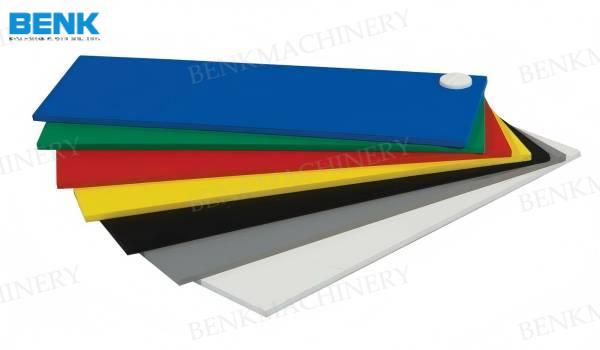In this article, we will introduce various processing technologies, customization options, and post-processing methods for PVC board, helping you better understand how to customize PVC board based on specific needs to achieve optimal performance and results.
PVC Board Processing Technologies
-
Cutting:
- Laser Cutting: This method is ideal for small batch production and precise cuts, especially when working with intricate designs.
- Mechanical Cutting: On the other hand, mechanical cutting uses saw blades or knives to quickly cut large quantities of simple shapes.
- Blade Cutting: For thinner PVC board, you can use thin blades to achieve a clean and smooth cut.
-
Thermoforming:
- PVC boards are heated until they soften, allowing you to shape them into complex forms using molds. This technique is particularly useful for creating decorative trims, pipe fittings, and similar products.
-
Welding:
- Hot Air Welding: In this process, you heat the edges of two PVC baords and weld them together. It works well for large or non-standard baords.
- Hot Plate Welding: Alternatively, hot plate welding is suitable for thicker PVC baords, where you heat the joint to bond the materials.
-
Printing:
- Silkscreen Printing: This method is perfect for large-scale printing projects, such as signs, labels, and packaging.
- UV Printing: UV printing cures the ink with UV light, offering better durability and making it ideal for outdoor applications.
- Heat Transfer Printing: For small batch production, heat transfer printing is excellent for handling complex custom designs.
-
Drilling and Engraving:
- You can drill holes in PVC boards for uses like display racks or furniture. Additionally, engraving adds detailed textures or patterns, enhancing the aesthetic value.
PVC Board Customization Options
-
Size Customization:
- PVC boards are available in a wide range of thicknesses (from 1mm to 25mm) and sizes (length and width), so you can easily customize them to meet your specific project needs.
-
Color Customization:

- Although PVC boards come in standard colors like white, black, grey, and blue, suppliers also offer custom colors. Furthermore, some even provide printed patterns or gradient colors for a more personalized look.
-
Surface Treatment Customization:
- Glossy: A glossy finish gives a smooth, shiny surface, often used for interior decorations or display boards.
- Matte: If you want a non-reflective finish to reduce glare, matte surfaces are ideal for decorative designs.
- Textured: For an elegant touch, textured surfaces—such as wood or stone patterns—add visual appeal to furniture or wall panels.
- Anti-slip: Finally, for safety, anti-slip treatments are especially useful in outdoor or high-traffic areas.
-
Functional Customization:
- Fire Resistance: Some PVC baords use fire-retardant materials, making them suitable for construction projects where fire safety is essential.
- UV Resistance: PVC boards designed for outdoor use resist UV rays, preventing fading and degradation over time.
- Anti-static: For the electronics industry, anti-static properties help prevent damage from static buildup.
- Corrosion Resistance: With the addition of certain additives, PVC can resist chemicals or moisture, making it ideal for harsh environments.
Post-Processing Methods of PVC Board
-
Sanding and Polishing:
- Sanding and polishing smooth the surface, improving the appearance and preparing it for further processing, especially when used in decorative applications.
-
Laminating:
- PVC Film: Laminating with a thin PVC film enhances UV and water resistance, making it perfect for outdoor signage and wall coverings.
- Metal Film: Some PVC boards are laminated with a metallic film, which increases durability and gives them a high-end look, ideal for premium furniture or signage.
-
Bonding and Joining:
- To create larger panels, you can bond or weld PVC boards together. This method is particularly useful when you require seamless connections, such as in architectural projects.
Applications of PVC Board Customization
- Construction: PVC boards are widely used in construction for interior and exterior wall panels, ceilings, floors, and window frames due to their versatility and durability.
- Advertising: Thanks to their durability and ease of customization, PVC boards are ideal for signs, display racks, lightboxes, and outdoor advertisements.
- Furniture: In the furniture industry, PVC is used for table surfaces, cabinet doors, and furniture panels, offering both a stylish and durable finish.
- Automotive: PVC boards also find applications in automotive interiors, such as door panels and dashboards.
- Electronics: Finally, PVC boards with anti-static or heat-resistant properties protect sensitive electronic devices from damage.
